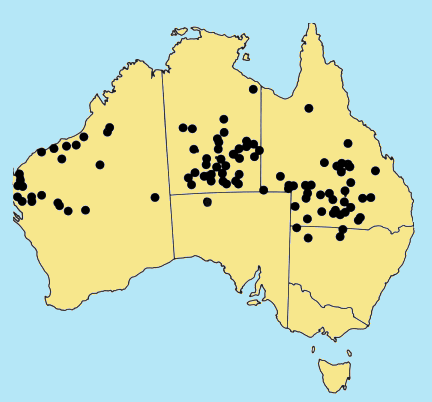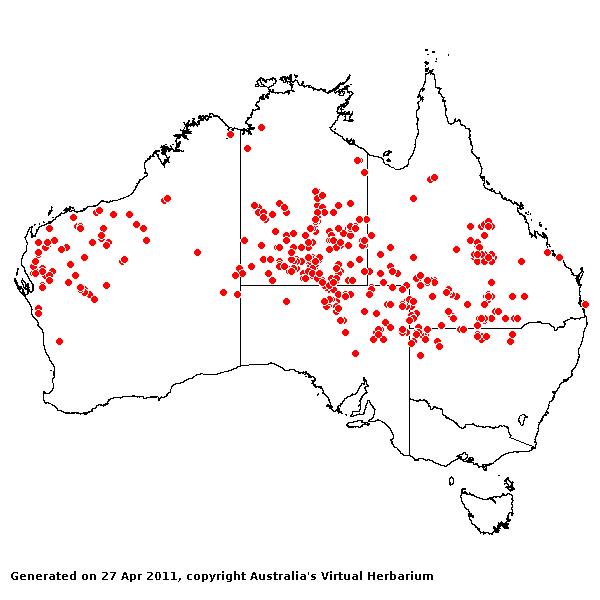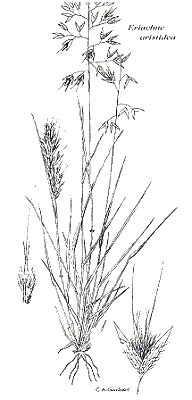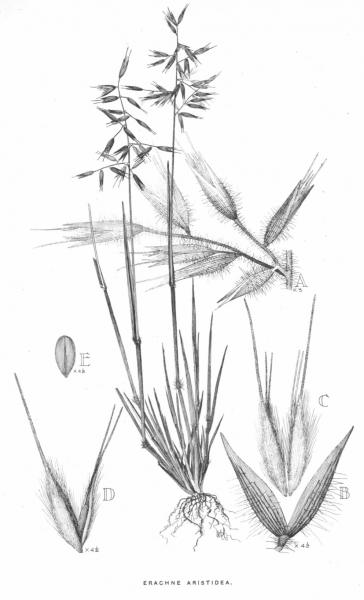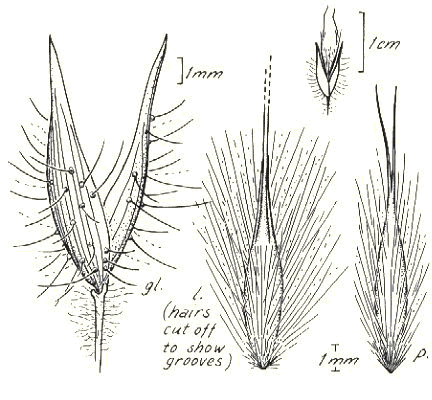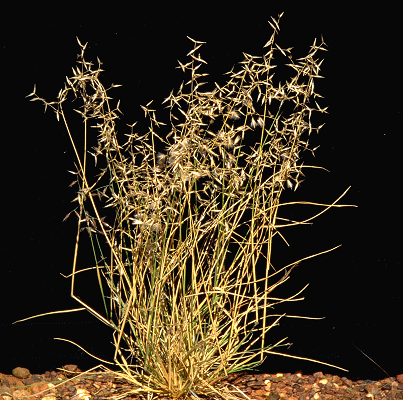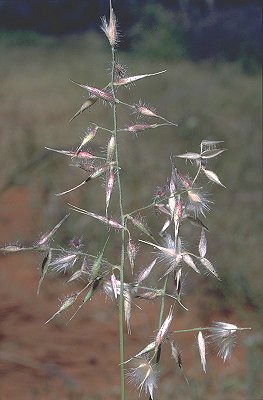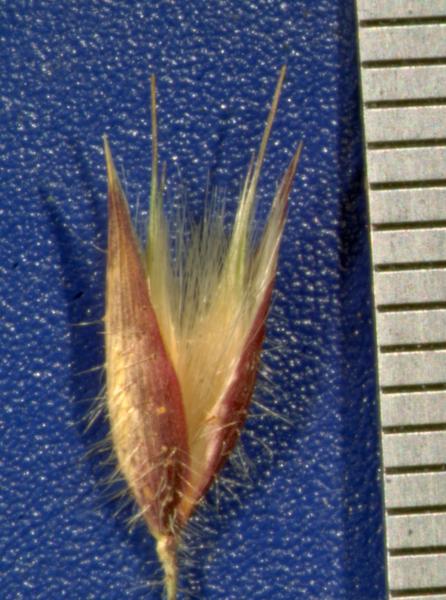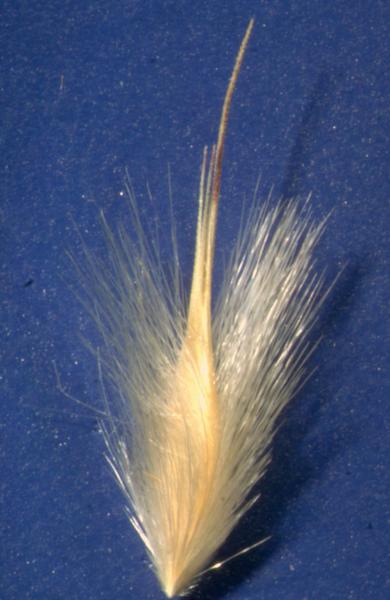Eriachne aristidea F. Muell. Fragm.
5: 205 (1866).
Classification. (GPWG 2001) : Subfamily
Micrairoideae. Eriachneae.
Type of Basionym or
Protologue Information: HT: Oldfield s.n., Australia: Western
Australia: Eremaean Province, near Oolingara, Murchinson River (MEL; IT: BR, K,
PERTH).
Recent synonyms:
E. aristidea var. minor, E. gardneri.
Key references
(books and floras): [1878] G.Bentham, Flora Australiensis 7 (629),
[1952] C.A.Gardner, Flora of Western Australia 1 Gramineae (46),
[1981] M.Lazarides in J.Jessop (ed)., Flora of Central Australia (442 as
E. aristidea var. aristidea), [2002] D.Sharp & B.K.Simon, AusGrass,
Grasses of Australia, [2006] J.Jessop, G.R.M.Dashorst, F.M.James, Grasses
of South Australia (419), [2008] S.W.L.Jacobs, R.D.B.Walley &
D.J.B.Wheeler, Grasses of New South Wales (260).
Illustrations:
[1952] C.A.Gardner, Flora of Western Australia 1 Gramineae (47
& 53, Pl. 12 & 13), [2006] J.Jessop, G.R.M.Dashorst, F.M.James, Grasses
of South Australia (420, fig. 350),
[2008] S.W.L.Jacobs, R.D.B.Whalley & D.J.B.Wheeler, Grasses of New South
Wales, 4th edn (260).
Habit. Annual or
perennial. Culms geniculately ascending, 6–48 cm tall, 1–3 -noded. Mid-culm
nodes bearded. Lateral branches simple or sparsely branched or fastigiate.
Leaf-sheaths glabrous on surface or hairy. Ligule a fringe of hairs.
Leaf-blades flat or conduplicate or involute, 7–19 cm long, 3–6 mm wide.
Leaf-blade surface smooth or scabrous, glabrous or indumented.
Inflorescence.
Inflorescence compound, a panicle. Panicle elliptic, 4–10 cm long, 2–6 cm wide.
Spikelets.
Spikelets pedicelled. Fertile spikelets 2-flowered, both fertile, comprising 2
fertile floret(s), without rachilla extension, ovate, laterally compressed,
8–10 mm long.
Glumes.
Glumes similar, thinner than fertile lemma. Lower glume lanceolate or ovate,
membranous, without keels, 9–13 -nerved. Lower glume surface glabrous or
indumented. Lower glume apex muticous. Upper glume lanceolate or ovate,
4.5–9.3(–11.5) mm long, membranous, without keels, 9–13 -nerved. Upper glume
surface glabrous or indumented. Upper glume apex muticous.
Florets.
Fertile lemma 5.8–9 mm long, without keel, 5–7 -nerved. Lemma surface
indumented. Lemma apex awned, 1 -awned. Median (principal) awn 4–10 mm long
overall. Palea apex lobed, awned (2). Grain 2.8–3.8 mm long.
Continental
Distribution: Australasia.
Australian
Distribution: Western Australia, Northern Territory, South Australia,
Queensland, New South Wales.
Western Australia:
Gardner. Canning, Keartland, Giles, Fortescue, Ashburton, Carnarvon, Austin. Northern
Territory: Victoria River, Barkly Tableland, Central Australia North,
Central Australia South. South Australia: Lake Eyre. Queensland:
Burke, South Kennedy, Port Curtis, Leichhardt, Gregory North, Gregory South,
Mitchell, Warrego, Maranoa. New South Wales: North-Western Plains, North
Far Western Plains.
Notes.
Typical plants of the species can be diagnosed by the leafy compact short-lived
habit, panicles scattered throughout the plant, large spikelets, hairy
tubercled glumes, awned bisulcate lemmas concealed by indumentum, two-awned
paleas, and strongly compressed caryopsis. There is considerable variation in
spikelet dimensions, awn length, and the indumentum on foliage and spikelets.
Endemic. A
characteristic species of the arid interior, but extending into semi-arid areas
in Qld and N.S.W. A common species of sand dunes, sand plains and sand hills;
also of seasonally flooded, alluvial sandy or loamy floodplains, levees and
swales; sometimes also in shallow, stony soils on sandstone and quartzite
outcrops and ridges. Flowers and fruits in all seasons in N.T., S.A. and Qld,
and chiefly Apr.-Nov. (autumn to spring) in W.A. and N.S.W.
